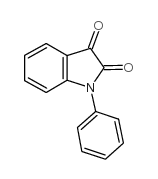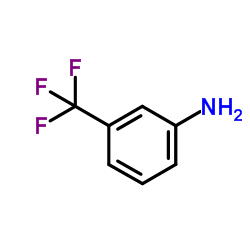303149-14-6
| Name | 1-phenyl-3-[3-(trifluoromethyl)phenyl]iminoindol-2-one |
|---|---|
| Synonyms |
1-phenyl-3-[[3-(trifluoromethyl)phenyl]imino]-1,3-dihydro-2H-indol-2-one
1-phenyl-3-[[3-(trifluoromethyl)-phenol]-imino]-1H-indol-2-one 1,3-dihydro-1-phenyl-3-[[3-trifluoromethylphenyl]imino]-2H-indol-2-one 1-phenyl-3-{[3-(trifluoromethyl)phenyl]azamethylene}benzo[d]azolidin-2-one HT-2157 |
| Description | HT-2157 (SNAP 37889) is a selective, high-affinity, competitive antagonists of galanin-3 receptor (Gal3). |
|---|---|
| Related Catalog | |
| Target |
Galanin-3 receptor[1] |
| In Vitro | HT-2157 (SNAP 37889) binds with high affinity to membranes from transiently transfected LMTK- cells expressing the human Gal3 receptor (Ki=17.44±0.01 nM; n>100) and is highly selective for Gal3 over the Gal1 and Gal2 subtypes (Ki>10,000 nM for each subtype; n=46 of each subtype). When tested for the antagonism of galanin-evoked inhibition of adenylyl cyclase, HT-2157 (0.1-10 μM) produces concentration-dependent rightward shifts of the concentration-effect curve to galanin[1]. |
| In Vivo | The galanin-3 receptor antagonist, HT-2157 (SNAP 37889), reduces operant responding for ethanol in alcohol-preferring rats. The novel selective GALR3 antagonist, HT-2157, to reduce anxiety-like behaviour and voluntary ethanol consumption in the iP (alcohol-preferring) rat. Male iP rats treated with HT-2157 at a dose of 30 mg/kg (i.p.) do not show altered locomotor activity or changes in anxiety-like behaviour in the elevated plus maze or light-dark paradigms. Treatment with HT-2157 (30 mg/kg, i.p.) reduces operant responding for solutions containing ethanol, sucrose and saccharin. Collectively, results from the current study shows that HT-2157 (30 mg/kg, i.p.) is effective in reducing operant responding for ethanol, independent of a sedative effect[2]. |
| Kinase Assay | Binding affinities for HT-2157 (SNAP 37889) and SNAP 398299 at the human Gal1, Gal2, and Gal3 receptors are determined by using the 125I-galanin displacement assay. Additionally, is tested for binding in a broad cross-reactivity panel that included G-protein-coupled receptors, ion channels, enzymes, and transporters. The ability of HT-2157 to antagonize functional responses to galanin is examined in modified HEK-293 cells (PEAKrapid cells) transiently cotransfected with the Gal3 receptor and Gαz by measuring the inhibition of adenylyl cyclase activity[1]. |
| Animal Admin | Rats[2] The effect of HT-2157 on locomotor activity is examined using adult male iP rats (n=12; 418-467 g). Locomotor activity is tested to ensure that any potential change in anxiety or ethanol consumption in subsequent tests is not due to any sedative property of the drug. Rats are habituated to the locomotor cells (26×26×40 cm) for 60 minute sessions which are conducted daily for three consecutive days. To minimise the effect of habituation during the treatment phase, rats are divided into two even groups which received a single injection of either HT-2157 (30 mg/kg, i.p.) or vehicle (1 ml/kg i.p.) 30 min prior to being placed in the locomotor cells for a 60 minute session. The following day the treatments are reversed so that all rats received treatment with both the vehicle and SNAP 37889 compound. Movements in terms of number of moves, move time (s) and total distance travelled (cm), are recorded automatically using TruScan 2.0 software. |
| References |
| Molecular Formula | C21H13F3N2O |
|---|---|
| Molecular Weight | 366.33600 |
| Exact Mass | 366.09800 |
| PSA | 32.67000 |
| LogP | 5.56950 |
| Storage condition | 2-8℃ |
|
~88% 
303149-14-6 |
| Literature: SYNAPTIC PHARMACEUTICAL CORPORATION Patent: WO2004/14855 A1, 2004 ; Location in patent: Page 35; 38-39 ; |

